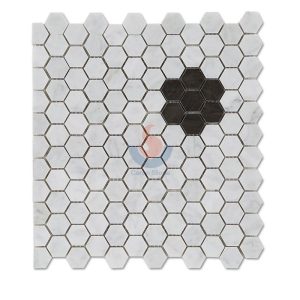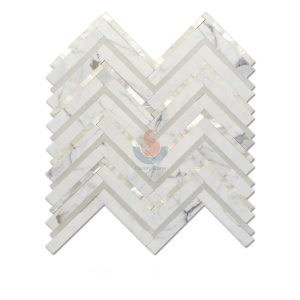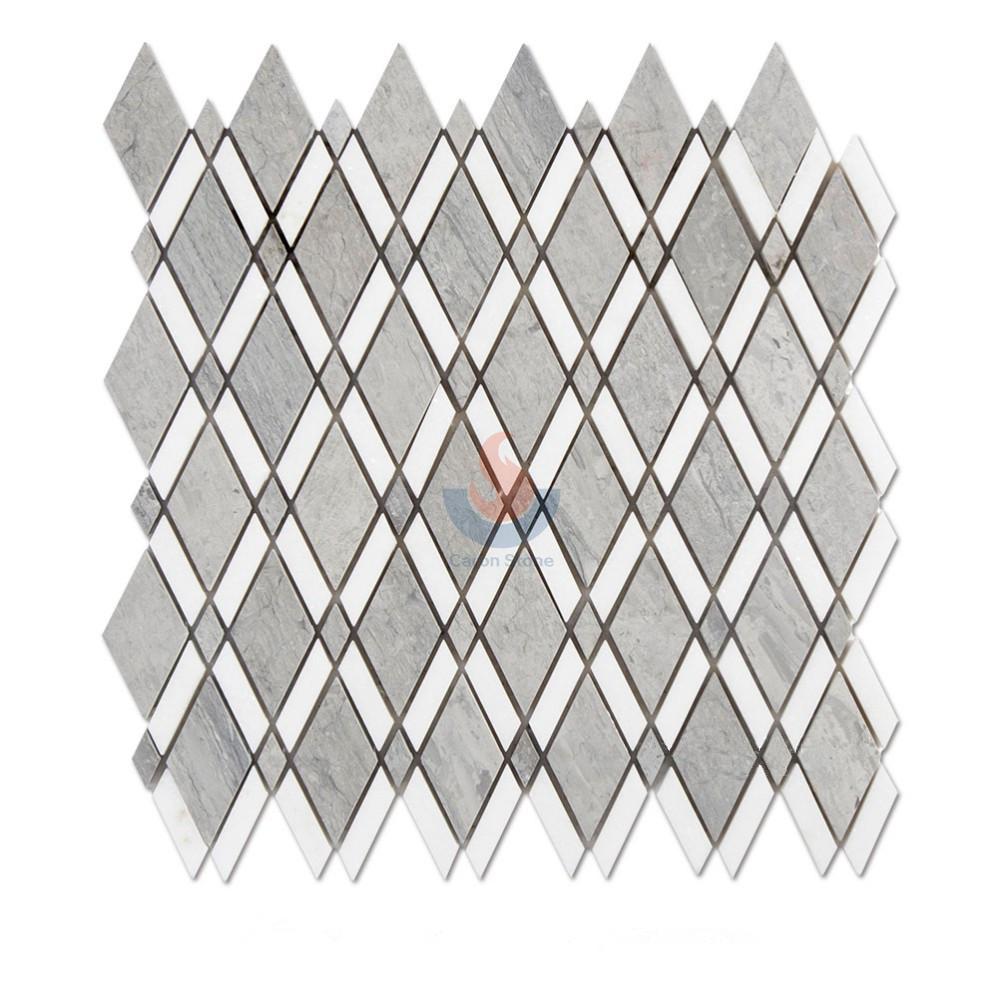Mosaic marble tiles, this ancient and modern decorative material, is like a magician who can turn any space into an artistic canvas. Whether it’s the textured artwork on the kitchen floor or the dazzling light on the bathroom wall, its presence makes regular houses remarkable right away. Today, we will explore the huge charm hidden behind this small tile, unveil the mystery of its widespread application from ancient times to the present, from east to west, and explore its important role in modern home decoration.

Carrara White Marble Hexagon Mosaic Tile
Historical Review of Mosaic Marble Tiles
Mosaic art can be traced back to ancient Greece and Rome, when artists used colored glass, stone and ceramic fragments to create beautiful patterns to decorate palaces, temples and public baths. Marble, among the most opulent materials, became inevitably significant in mosaics. Carefully placed, these marble pieces create intricate geometric patterns, floral designs, even portraits. They are not only lovely but also represent riches and authority.
In the Middle Ages, mosaic art began to become popular in churches and religious buildings in Europe. Marble remains in a key role as mosaic workmanship is progressively used on a greater spectrum of architectural ornamentation as time passes.
Manufacturing process of mosaic marble tiles
Today’s mosaic marble tiles are no longer just a stack of stones, but a fine craft. Material choosing marks the beginning of the production process. Usually chosen is a hard-textured marble with exquisite texture; it is then cut and polished among several techniques. These marble blocks then are collaged to create several designs and patterns.
Different patterns require different cutting and arrangement methods, such as fish scales, hexagons or honeycombs. These trends are mathematical art as well as visual delight. Mosaic marble tiles may produce remarkably complex and beautiful patterns by combining several colors and forms.
In addition, the introduction of modern technology has made the production process of these tiles more refined and efficient. Technologies like laser engraving and CNC cutting machines not only increase manufacturing efficiency but also significantly widen the design options for mosaic marble tiles.
mosaic marble tile use scenarios
Mosaic marble tiles are widely used in various scenarios due to their rich design sense and luxurious texture. They might be artistic embellishment to liven the atmosphere or for large-area pavement.
1. bathroom:
Mosaic marble tiles are very common in bathrooms. You can see the wall, floor, or background wall of the shower room as well as others. Marble’s natural sheen and texture give the bathroom a calm and noble vibe; the mosaic design adds layering and interest.
2. kitchen:
Another primary application site for mosaic marble tiles is the kitchen. They are often used in the splashback or floor area of the kitchen, adding a touch of natural texture to the kitchen. Its water and heat-resistant qualities help it to function in the high temperature and high humidity of the kitchen and enable daily oil smoke and stain control.
3. Living room and entrance:
Usually floor or fireplace décor in the living room or entrance area uses mosaic marble tiles. They can not only create a striking focal point, but also match harmoniously with other decorative elements to form a unified design style. Not only are mosaic marble tiles aesthetically pleasing and giving, but they also make a strong impact right away at first house entrance.
4. Commercial space:
In addition to residential buildings, mosaic marble tiles are also widely used in commercial spaces such as hotel lobbies, restaurants, and shopping malls. Usually, these locations should exhibit elegance and taste; the beautiful texture of marble tiles surely satisfies this desire. Whether as a wall decoration or floor paving, they can improve the space’s artistic environment and grade.
Design style of mosaic marble tiles
Mosaic marble tiles include a range of designs, from traditional to modern, and each one can fit in different environments.
1. Classic style:
Usually based on simple geometric forms and monotone, classic style mosaic marble tiles fit for conventional interior design. Though the design of black and white matching or a single color system seems simple, the variations of light and shadow can reveal a special feeling of spatial hierarchy.
2. Modern style:
Modern style pays more attention to the creativity of patterns and the contrast of colors, and common ones are abstract patterns or bold color splicing. This kind of mosaic marble tiles can provide visual impact and freshness and fit for homes or businesses aiming at uniqueness and trend.
3. Retro style:
The retro style returns to the origin of mosaic art, characterized by complex patterns and multi-tones. The design full of historical and cultural sense gives the area a special historical ambiance as though people are returning to the old Roman or Byzantine era.
4. Natural style:
Natural style mosaic marble tiles emphasize the natural texture and color of marble itself, and show the original beauty of nature through irregular splicing and arrangement. Ideal for areas stressing comfort and natural surroundings, including ecological restaurants or hot spring resorts.
Advantages of mosaic marble tiles
Mosaic marble tiles’ several benefits help to explain their place in ornamental materials.
1. Durability:
Marble is a hard and wear-resistant material, and the processed tiles have extremely high durability. For a long period, they can maintain the surface of high-frequency use areas like floors and walls bright and clean as new.
2. Anti-fouling:
Marble tiles have a smooth surface, stains are not easy to penetrate, and daily cleaning is very convenient. Particularly in stain-prone spaces like bathrooms and kitchens, mosaic marble tiles hold great performance.
3. Environmental protection:
Marble is a natural stone without the chemical components of artificial synthetic materials, so it is more environmentally friendly. Coupled with the improvement of modern processing technology, the production process of marble tiles is more energy-efficient and reduces the impact on the environment.
4. Aesthetics:
Marble’s inherent brilliance and texture set it apart among many decorative materials. By splicing tiny bits, mosaic marble tiles vividly display these textures and hues, therefore rendering each tile a singular piece of art.
5. Diversity:
Mosaic marble tiles can be cut into various shapes and sizes according to design requirements, and spliced into a variety of patterns and styles, with extremely high design freedom. Its adaptability to several decorative styles and space constraints depends on this variety.
Mosaic marble tile care and maintenance
Although mosaic marble tiles are quite stain-resistant and robust, their long-term beauty and service life depend on appropriate maintenance even if these tiles are rather strong.
1. Regular cleaning:
Regular cleaning with a neutral detergent and a soft cloth can effectively remove stains and dust on the surface. Steer clear of strong acidic or alkaline detergues to prevent marbles’ surface damage.
2. Protective treatment:
Regular preventive treatment—that is, applying a stone-specific protective agent to create a protective film—can help to prevent oil or water stains on the marble surface.
3. Timely repair:
Should scratches or wear show on the tile’s surface, a specific marble repair agent can be applied to fix it so as to stop the problem from spreading and compromising the tile’s general look.
4. Avoid heavy impact:
Particularly on the floor and corners, try to avoid heavy objects straight impacting the surface of marble tiles to prevent fractures or corner collapse.

Calacatta Gold Marble Mix Pearl Shell HerringboneChevron Mosaic Tile
Mosaic marble tiles, with their unique historical background, exquisite craftsmanship and rich design style, have become an indispensable part of modern decoration. From contemporary luxury hotels to historic Roman baths, it can exhibit special creative appeal in both personal and business environments. Through reasonable design and maintenance, these small and exquisite tiles can not only enhance the visual effect of the space, but also highlight the taste and personality of the residents. Though modest in scale, mosaic marble tiles offer countless opportunities just waiting for us to find and investigate.





